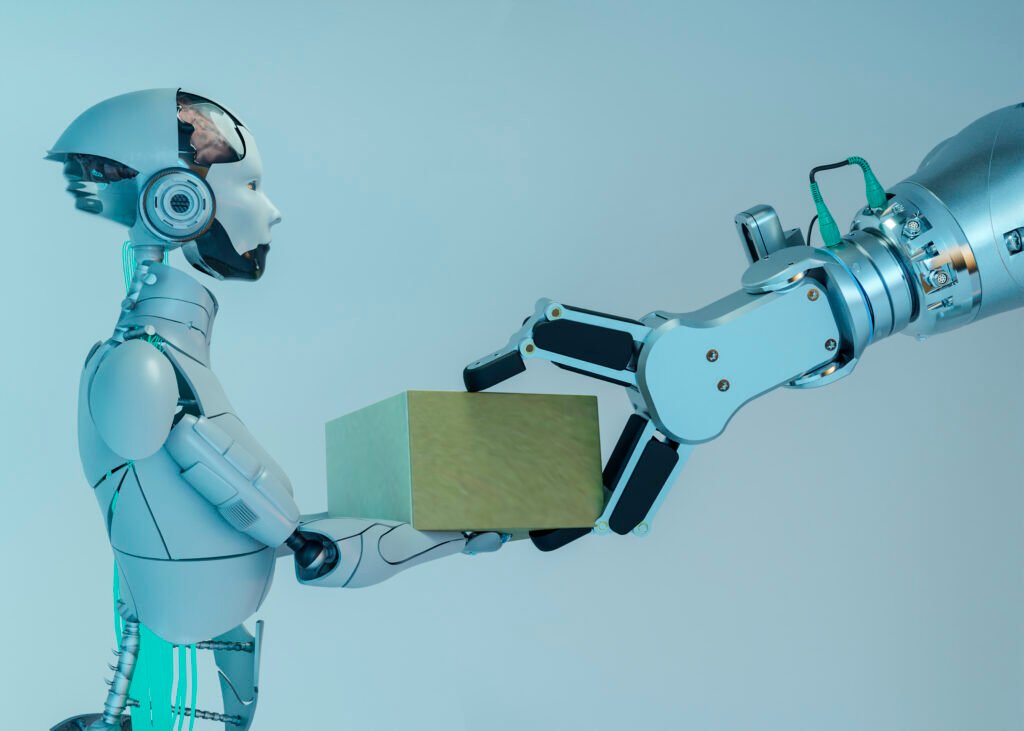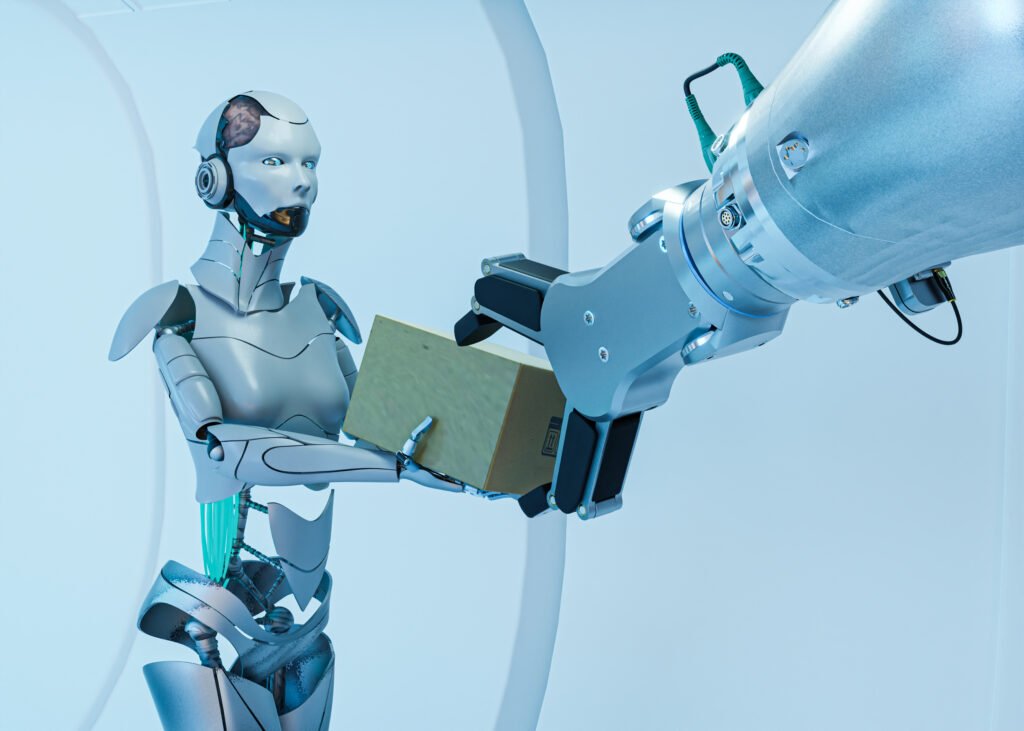What Actually AI and Robotics are?
As technology continues to advance at an unprecedented rate, two terms that have become increasingly prominent are Artificial Intelligence (AI) and Robotics. While often used interchangeably, AI and Robotics are distinct concepts that are revolutionizing industries across the globe.
Artificial Intelligence (AI) is the emulation of human intelligence in machines, which are designed to mimic and learn from human-like thinking processes. AI systems are designed to analyse vast amounts of data, recognize patterns, and make decisions based on the information provided. This technology has the potential to transform various sectors, ranging from healthcare to finance, by enabling machines to perform complex tasks with remarkable precision.
On the other hand, Robotics involves the design, creation, and operation of robots. These are physical machines that can be programmed to perform specific tasks autonomously or with minimal human intervention. Robotics incorporates AI to enhance the capabilities of these machines, allowing them to perform tasks that were once thought to be exclusively reserved for humans.
Understanding the Basics of AI
Artificial Intelligence is a branch of computer science that focuses on creating intelligent machines capable of performing tasks that typically require human intelligence. AI systems are designed to analyse vast amounts of data, recognize patterns, and make decisions based on that information. Machine Learning and Deep Learning are two key components of AI that enable computers to learn and improve over time without explicit programming. These technologies have paved the way for advancements in natural language processing, computer vision, and autonomous systems.
The Evolution of Robotics
The realm of robotics has made significant strides since its inception. Initially, robots were designed to perform repetitive tasks in controlled environments. However, with advancements in AI, robots have become more intelligent, adaptable, and capable of interacting with their surroundings.
Collaborative robots, known as cobots, are now being employed alongside humans in manufacturing and healthcare settings, increasing productivity and efficiency. The integration of AI and Robotics has also led to the development of autonomous robots that can navigate complex environments, such as self-driving cars and drones.
The Impact of AI and Robotics on Various Industries
The combination of AI and Robotics has the potential to revolutionize a wide range of industries. In healthcare, AI-powered robots are assisting surgeons in complex procedures, helping diagnose diseases, and providing personalized patient care. In manufacturing, robots are streamlining production lines, improving quality control, and increasing productivity.
Transportation is another sector where AI and Robotics are making significant advancements, with self-driving cars and delivery drones on the horizon. In education, AI is enhancing personalized learning experiences, while in entertainment, AI-powered virtual assistants and chatbots are transforming customer interactions.
Applications of AI in Various Industries
The applications of AI are vast and diverse, with numerous industries harnessing its power to streamline operations and improve efficiency. In the healthcare sector, AI is being used to analyse medical records, identify disease patterns, and assist in diagnosis. AI-powered robots can even perform complex surgeries with greater precision, reducing the risk of human error.
In the finance industry, AI is transforming the way businesses handle transactions, manage investments, and detect fraudulent activities. AI algorithms can analyse financial data in real-time, predicting market trends and making informed investment decisions. Chabot’s powered by AI are revolutionizing customer service, providing instant support and personalized recommendations.
Another industry benefiting from AI is transportation. Self-driving cars, enabled by advanced AI systems, are poised to revolutionize the way we commute. These vehicles can navigate roads, detect obstacles, and make split-second decisions to ensure passenger safety. AI is also being utilized in logistics operations, optimizing routes and improving supply chain management.
Advantages and Disadvantages of AI and Robotics
While the benefits of AI and Robotics are undeniable, it is important to consider both the advantages and disadvantages they bring. On one hand, AI and Robotics have the potential to increase efficiency, accuracy, and productivity, leading to cost savings and improved outcomes.
They can also perform tasks that are dangerous, repetitive, or beyond human capabilities. However, there are concerns regarding job displacement, as automation may replace certain job roles. Ethical considerations surrounding data privacy, algorithm bias, and the potential misuse of AI and Robotics need to be addressed.

Ethical Considerations in AI and Robotics
As AI and Robotics become more prevalent in our lives, ethical considerations become increasingly important. One of the key concerns is algorithm bias, where AI systems may inadvertently perpetuate discrimination or reinforce existing biases present in the data they are trained on.
Transparency and accountability in AI algorithms are essential to ensure fairness and prevent unintended consequences. Privacy and data protection should be prioritized, as AI systems often require access to personal information. Striking a balance between the benefits and risks of AI and Robotics is crucial for responsible development and deployment.
AI and Robotics in Everyday Life
AI and Robotics have already become integrated into our everyday lives in various ways. Virtual assistants, such as Amazon’s Alexa and Apple’s Siri, utilize AI to understand and respond to voice commands, helping with tasks such as setting reminders, answering questions, and controlling smart home devices.
AI algorithms power recommendation systems on streaming platforms, suggesting movies and music tailored to individual preferences. Robotics, on the other hand, can be seen in the form of autonomous vacuum cleaners and lawn mowers that take care of household chores, freeing up time for other activities.
AI and Robotics in Healthcare
The healthcare industry is witnessing a significant transformation with the integration of AI and Robotics. AI-powered diagnostic systems can analyse medical images, detect abnormalities, and assist physicians in making accurate diagnoses. Robots are being used in surgical procedures, where their precision and stability reduce the risk of human error.
Telemedicine, enabled by Artificial Intelligence (AI) and Robotics, allows patients to receive remote consultations and continuous monitoring, improving access to healthcare services. AI algorithms can also predict disease outbreaks and assist in drug discovery, revolutionizing the field of medical research.
AI and Robotics in Manufacturing
The manufacturing sector has long been a pioneer in adopting robotic systems. AI-powered robots are revolutionizing production lines by performing tasks with speed, accuracy, and consistency. Collaborative robots, often referred to as cobots, operate alongside human workers to enhance productivity and safety.
AI algorithms analyse data from sensors and machines to optimize production processes, reduce downtime, and predict maintenance needs. Robotic automation in manufacturing leads to improved productivity, cost savings, and the ability to handle complex tasks that were previously difficult or impossible for humans.
AI and Robotics in Transportation
Transportation is another industry that is being transformed by AI and Robotics. Self-driving cars, equipped with AI algorithms and sensors, have the potential to revolutionize transportation by improving safety, reducing traffic congestion, and increasing fuel efficiency. Autonomous delivery drones are being developed to streamline the delivery process, especially in areas with challenging terrain or limited infrastructure.
AI-powered systems are also used in traffic management, analysing real-time data to optimize routes and reduce travel time. The integration of Artificial Intelligence (AI) and Robotics in transportation holds the promise of a future with reduced accidents, improved sustainability, and enhanced mobility.
AI and Robotics in Education
The field of education is experiencing the impact of AI and Robotics, revolutionizing the way students learn and teachers teach. AI-powered educational platforms provide personalized learning experiences, adapting the curriculum to individual needs and preferences. Intelligent tutoring systems utilize AI algorithms to provide feedback, assess student progress, and identify areas for improvement.
Robots are being used as educational aids, engaging students in interactive learning activities and enhancing their understanding of complex concepts. AI and Robotics have the potential to bridge educational gaps, improve access to quality education, and empower learners of all ages.
AI and Robotics in Entertainment
Entertainment is another domain where AI and Robotics are making their mark. AI algorithms analyse user data to recommend personalized content on streaming platforms, enhancing the entertainment experience. Chabot’s and virtual assistants powered by AI interact with users, providing information, answering queries, and even simulating human conversation.
Robotics is also entering the realm of entertainment, with humanoid robots capable of performing complex movements and interacting with audiences. The integration of Artificial Intelligence (AI) and Robotics in the entertainment industry opens up new possibilities for immersive experiences, storytelling, and creative expression.
AI and Robotics in the Future
The future of AI and Robotics is filled with endless possibilities. As technology continues to advance, we can expect further integration of Artificial Intelligence (AI) and Robotics into our daily lives and industries. The development of more advanced AI algorithms, coupled with advancements in robotics hardware, will lead to even more intelligent, autonomous, and adaptable systems.
However, it is important to ensure that the ethical considerations surrounding AI and Robotics are addressed, allowing for responsible and beneficial deployment. The future promises a world where AI and Robotics work hand in hand with humans, augmenting our capabilities and shaping a new era of technological advancement.
Examples of AI and Robotics Integration
The integration of AI and Robotics has resulted in ground-breaking innovations across various fields. One such example is the healthcare industry, where robotic surgery systems are transforming surgical procedures. These systems, guided by AI algorithms, can perform precise and minimally invasive surgeries, reducing patient recovery time and improving surgical outcomes.
In the retail sector, AI-powered robots are being utilized for inventory management and customer assistance. These robots can navigate store aisles, track inventory levels, and provide personalized recommendations to customers. By automating these tasks, retailers can improve efficiency and enhance the overall customer experience.
Another example is the use of Artificial Intelligence (AI) and Robotics in the field of education. AI-powered tutoring systems can adapt to individual learning styles, providing personalized instruction and feedback to students. Robots are also being used in special education to assist children with cognitive and physical disabilities, promoting inclusivity and enhancing learning outcomes.
Conclusion
The power of AI and Robotics is undeniable. These technologies have the potential to revolutionize various industries, improve efficiency, and enhance our everyday lives. From healthcare to manufacturing, transportation to education, and entertainment to the future, AI and Robotics are shaping the way we live and work. However, it is essential to consider the ethical implications and address concerns surrounding these technologies.
By embracing responsible development and deployment, we can unleash the full potential of AI and Robotics and create a future where humans and machines coexist harmoniously, driving innovation and progress. Let us embrace the power of Artificial Intelligence (AI) and Robotics and embark on a journey towards a technologically advanced future.
Subscribe to our newsletter to receive future updates on Technology, Artificial Intelligence (AI), and Tech Trends. Explore our categories to find more relevant stuff. Stay informed and motivated with our most recent insights!

